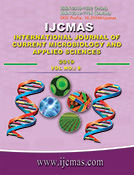


 National Academy of Agricultural Sciences (NAAS)
National Academy of Agricultural Sciences (NAAS)

|
PRINT ISSN : 2319-7692
Online ISSN : 2319-7706 Issues : 12 per year Publisher : Excellent Publishers Email : editorijcmas@gmail.com / submit@ijcmas.com Editor-in-chief: Dr.M.Prakash Index Copernicus ICV 2018: 95.39 NAAS RATING 2020: 5.38 |
On farm trials in ten locations were conducted to evaluate efficacy of eco-friendly IPM strategies with emphasis on use of pheromone traps for management of brinjal shoot and fruit borer (Leucinodes orbonalis Guenee) and to create awareness among the farming community on brinjal fruit and shoot borer management during rabi, 2014-15 to 2017-18 in the farmer’s fields in Krishna District of Andhra Pradesh. By adoption of eco-friendly IPM practices in all the four years, the shoot damage was reduced on an average by 4.02 per cent compared to 9.19 per cent in farmers practice. The fruit damage on an average was also reduced by 16.42 per cent compared to 31.55 per cent in farmers practice. The total moth trap catches per trap per season on an average was 86.64 helping in reducing the pest load, damage and enabled in correct decision making in application of insecticides. This has resulted in reduction in the average cost of cultivation by Rs. 17089.00 per hectare and the average net income was improved by Rs. 51009 per hectare compared to the farmers practice. The average yield levels improved by 12.94 per cent compared to farmers practice (35.7 qt/ha) and giving a clear message that adoption of IPM practices with emphasis on pheromone traps helped in reducing the pest levels, damage and improving yield; helps in improving the decision making capacity and net income levels to the resource poor farmers.
 |
 |
 |
 |
 |